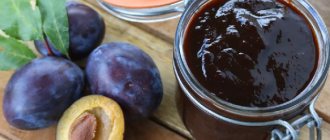Celery root has been known since Roman times. The wise Hippocrates advised using it daily. Already in those days it was known about its healing properties, as well as the presence of a huge amount of substances necessary for the body.
Celery is a biennial plant; today there are about 20 species. The plant is cold-resistant, so it can also be grown in northern latitudes. The most popular types are petiole, leaf, root celery .
The latter is becoming more and more popular. Increasingly, celery root can be found in stores, in the gardens and kitchens of Russians.
Composition and calorie content of celery
Celery is a dietary product related to vegetable crops, which has a fairly low calorie content of 13 kcal per 100 grams of product. But to process this amount the human body will need to spend up to 25 kcal. Thanks to this feature, called “negative calorie,” even a small amount of celery per day will help you stay slim.
The nutritional value primarily consists of carbohydrates, dietary fiber, followed by proteins, and there is very little fat in the vegetable. The chemical composition of the product makes it possible to use dishes from the culture as food, as well as use it to improve health. Its main part consists of:
- microelements (sodium, potassium, calcium, phosphorus, magnesium);
- vitamins (groups B, K, A, E);
- essential oils;
- carotene;
- ascorbic acid;
- asparagine;
- a nicotinic acid;
- tyrosine and others.
Combining everything that is contained in celery, we can talk about the need to consume it in food to increase the protective, supporting forces of the body, filling the internal systems with useful substances and compounds.
Useful properties of the plant
In addition to its dietary properties, the culture has a number of other positive differences. It is recommended for use by young people to maintain immunity, performance, and good mood. But the benefits of celery for the human body are especially noticeable in older age.
The general advantages of this representative of the plant world are the following functions:
On this topic:
Celery varieties - a selection of the most original options
Jul 9, 2018
Celery salad - an unusual combination of piquancy and diet
Jul 8, 2018
BACK FORWARD 1 of 4
- anti-inflammatory (due to the contained polysaccharides);
- supporting youth (antioxidants in the composition protect cellular tissue from damage and malignant neoplasms);
- cleansing (pectins help eliminate toxins, radioactive compounds, nicotine, alcohol, and drugs from the body);
- supporting immunity (plant juice combined with honey contains the optimal vitamin dosage);
- normalizing metabolism (proteins, fatty acids of the product are easily digested, celery is very useful for the stomach and intestines);
- enhancing potency (the components of the vegetable tone up and act as an aphrodisiac for men and women).
The vegetable also has a positive effect on strengthening the walls of blood vessels, normalizes blood pressure, cholesterol levels, and hemoglobin in the blood. The differences in the benefits of celery and how to use it depend on the type of plant and the composition of its parts.
Types of celery
The species and varietal diversity of the vegetable representative includes about 17 representatives. The main difference lies in the expression of one of the parts of the plant: roots, stems or leaves. The most common is the stem (petiole) type, most often grown by gardeners. In addition, the root variety is used, as well as leaf celery, the beneficial properties of which are used in cooking and folk medicine.
Stem celery
This variety of plant, also called petiolate, is distinguished by the presence of large succulent stems. The petioles have a rather pleasant light taste and aroma; they are eaten in almost any form. The stem representative is most often used in salads, as well as in soups and main courses.
The benefits and harms of petiole celery, as well as the peculiarities of cultivation, have long been appreciated by gardeners, cooks, and ordinary consumers. It is not picky for growing in the garden plot or in pots on the windowsill. Nutritional value is determined by the large amount of fiber, minerals, vitamins, as well as folic acid, which is very useful for women. Stem celery was used for the stomach even by our distant ancestors.
You can buy plant stems at the market or supermarket. And to determine the quality and ripeness of the product, it is recommended to break one of the stems with a sharp movement. In a good ripened vegetable, breaking is accompanied by an audible crunch.
Leaf celery
The leafy variety does not have massive roots or stems; it is represented by an abundant crown of green shoots. Celery greens, the beneficial properties of which are contained in the leaves, are used in cooking as an aromatic spice. As a seasoning, they are added to salads, side dishes, and soups; in their raw form, the leaves act as an excellent decoration for prepared dishes.
Smokers or those who have given up this addiction and want to remove nicotine from the body are advised to eat the leaves. Studying the benefits of celery leaves for this category of people, it was determined that they effectively remove toxins, waste, and protect against the threat of cancer.
This species is not as popular as the stem one, but its value for gardeners lies in its early ripening and abundant harvests. It is advisable for people who experience frequent nervous tension to eat celery more often. Leaves, the use of which they try to make a daily habit, will lower the level of stress hormones, normalize blood pressure, and dilate blood vessels.
Root celery
The root crop of the plant has a round or oblong shape, is quite massive, and has a bittersweet taste and rich aroma. Like other varieties, it is used when preparing fresh salads, it is also dried, pickled, added to soup, and is considered a delicious side dish for fish or meat dishes. A special feature of its use in cooking is the ability to replace salt with much greater benefit.
Among the interesting facts from the past, the tradition of giving newlyweds dishes that use celery stands out. The roots of the plant enhance and treat male potency. And it is recommended for women to maintain a beautiful figure, improve the condition of nails, hair, and skin. There is a positive effect of food from root varieties on attentiveness, vision, memory in adults and children.
You can buy plant roots in stores and supermarkets all year round. In this case, heavier fruits are selected that have a smooth surface without a large number of depressions. In addition, dried celery root is prepared, the use of which is very convenient and useful.
Diseases and pests
Leaf celery, like all garden crops, is susceptible to pests and diseases. Therefore, it is very important to know and recognize the signs of damage in a timely manner in order to preserve the harvest.
Possible difficulties:
- Celery fly. Activates at the end of May. It lays larvae on leaves, which eat them. To destroy, you must use Inta-Vir and Actellik.
- Carrot flour. The pest appears in early spring, feeding on leaves, petioles, and roots of the plant. To fight, you should use Karate Zeon, Confidor Extra.
- Cercospora blight. It appears as rounded light spots with a red border. For treatment, the plantings should be sprayed with a solution of Fundazol.
- Powdery mildew. The disease can be recognized by a white coating on the leaves, which subsequently acquires a brown tint. Affected leaves eventually dry out. For treatment, “Skor” and “Topaz” should be used.
Use of celery in cooking
Since the vegetable crop is widespread on all continents (except Antarctica), it is used in almost all cuisines of the world. This popularity is caused not only by the unique benefits of the plant for the body, but also by the pleasant taste and aroma of the vegetable crop. Housewives and cooks also appreciate the possibility of using it in any form: raw, stewed, fried, baked, steamed, as a seasoning, and others.
When deciding how to use celery in cooking, the fact of maximum preservation of the nutrients in the raw stems, leaves, and roots of the plant is taken into account. Fresh petioles are used as an ingredient in salad, chopped as a side dish for meat dishes, and can serve as a base and preparation for various snacks.
On this topic:
How to grow root celery: subtleties of planting and care
How to plant celery: features of growing seedlings...
How to peel leaf, petiole, root celery
Storing petiole celery: in a container or in the garden
BACK FORWARD 1 of 3
The leaves and roots are often used as a seasoning for all kinds of dishes. To do this, they are very finely crushed or dried, which significantly lengthens the shelf life of the product. Dried celery, the use of which is primarily very convenient, serves as an excellent flavoring and aromatic additive to sauces, soups, side dishes, meat, fish; it is often used for pickling and pickling cucumbers, eggplants, and zucchini.
To store fresh petioles longer, they are placed in cold water and in this form in the refrigerator.
You can pamper yourself in the winter by preparing pickled celery. The benefits and harms of this method of cooking are almost completely preserved. Most often, root varieties are selected for preparation, but housewives also use leaf and stem pickled snacks.
https://www.youtube.com/watch?v=IbioDVKWyFc
Stewed celery with parmesan
Recipe for celery stewed with parmesan in tomato sauce.
What do you need:
- 2 stalks of celery
- 1 tbsp. spoon of tomato sauce
- 2 tbsp. spoons of olive oil
- 2 tbsp. tablespoons grated parmesan
- 2 tbsp. spoons of lemon juice
- 1 tbsp. spoon of flour
- Salt to taste
How to make Stewed Celery with Parmesan:
- Peel the celery, cut into slices and sprinkle with lemon juice.
- Sauté celery in oil with a tablespoon of water. Dry, roll in flour, salt and fry. Add tomato sauce.
- At the end, sprinkle with grated cheese.
- Stewed celery with ready.
Bon appetit!
Celery dishes are an ideal source of the lion's share of vitamins and the best way to boost immunity and strengthen the functioning of all body systems. In addition, by consuming such culinary compositions, you can enjoy their bright taste, inimitable aroma and maintain a slim figure.
Celery drinks
A variation on how to use celery root in cooking for medicinal purposes or to maintain youth, health, and prevent many diseases is the daily consumption of tea and juice from the vegetable. They are good diuretics, most often these drinks are used for:
- body weight control;
- cleansing the body of harmful substances;
- combating bloating and constipation.
Celery tea will be an effective addition to a cleansing diet. It is recommended to drink it in the morning on an empty stomach, cold or warm. Optimal use is in courses of 2-3 weeks and a break of a month.
The tea drink is prepared as follows:
- the stems are washed and finely chopped;
- a liter of water is brought to a boil;
- 3-4 chopped cuttings are placed in boiling water, the heat is reduced;
- tea is brewed for 5-10 minutes;
- the liquid is removed from the heat, cooled, and infused for 10-15 minutes.
To enhance the benefits and effectiveness of tea, add lemon, ginger, and sugar to taste.
Fresh juice retains all the benefits and harms of stem celery; its preparation and consumption do not cause any special difficulties or time. If you have a juicer, the whole process will take a few minutes; you just need to place the peeled stems in a grinding bowl. Nutritionists advise drinking juice before meals in the morning on an empty stomach (100 grams of juice) or 2-3 large spoons 3 times a day. To diversify the taste of the drink, you can make cocktails with the addition of other herbs, vegetables, and fruits.
What does celery root look like?
Celery root is a round, unusually aromatic root vegetable, with dense pulp of a bittersweet taste. Root celery reaches 10-20 centimeters in diameter, the lower part is occupied by root shoots, and the upper part of the root vegetable has soft leaves.
What does celery root look like?
Celery root is widely used both for culinary purposes and for the treatment of many diseases.
Use of celery in cosmetology
Cosmetologists, answering questions about whether celery is good for women, note its positive effect on the skin, nails, and hair. To improve the condition of the horny and hairy parts, the vegetable is often used in the form of food or drinks. To visually tighten, cleanse the skin, restore its youth, smoothness, and even tone, wiping lotions and masks are prepared.
A cleansing tonic prepared by pouring boiling water over chopped vegetable cuttings, leaving for 3-4 hours, and expressing is suitable for all skin types. Dried celery root is good for beauty; using it as a scrub will help renew the upper epidermis and remove impurities. A gauze compress is made from fresh juice, which is applied to a clean face for 15-20 minutes.
A celery mask for dry, normal skin is prepared from ground plant stems, chopped oatmeal, cream, and vegetable oil. For oily and combination skin, the stem juice is mixed with bean flour and chamomile. A mixture of green vegetables, cottage cheese, honey, and jojoba oil will help relieve fatigue and swelling. You can cleanse the problematic dermis with a mask that contains plant juice, clay, and aloe juice.
Celery essential oil is prepared from the seeds of the plant, the use of which helps to improve the functioning of the kidneys and liver, eliminate toxins, reduce swelling, temperature, inflammation, and calm the nervous system.
Recipe for cooking with spices in the oven
A side dish that has an extraordinary taste and is ideal for fish and meat dishes. If you have not tried dishes made from celery root before, then it’s time to start getting acquainted with this ingredient.
Ingredients:
- Dijon mustard – 12 g;
- celery root – 750 g;
- olive oil – 55 ml;
- coriander – 12 g ground;
- salt – 4 g;
- paprika – 12 g;
- ground black pepper – 7 g;
- garlic powder – 12 g.
Preparation:
- Rinse the root. Peel and cut into strips.
- Sprinkle with all the spices. Add mustard. Add salt. Fill with oil. Stir.
- Place on a baking sheet. Bake for half an hour. Place the baking sheet in a preheated oven to 200 degrees.
- Stir regularly with a spatula.
According to this recipe, you can use celery root as an independent dish or add it to salads.
The use of celery in folk medicine
To treat the body with traditional methods, all plant species are used. Infusions, decoctions, juices, lotions are prepared from dried roots, leaves, and stems. Celery in folk medicine is used to combat diseases of the gastrointestinal tract, genitourinary system, and allergic reactions.
For women, the vegetable is good for health and beauty; for men, it is used to improve potency, prevent prostatitis, adenoma, and reduce excess weight. The plant can be used even by young children; it improves appetite, sleep, and intestinal motility.
Celery tincture is prepared by pouring the crushed root (2-3 large spoons) with water (200 ml), letting it sit for 2-3 hours. You can infuse the rhizome into vodka or alcohol; in this form it is used as an additive to cocktails. The infusion is effective for allergies, insomnia, rheumatism, gout.
For gastritis and peptic ulcers, drink a decoction of celery. The benefits and harms of such a drink are almost identical to fresh juice. 20 grams of crushed root is mixed with boiling water, cooked over medium heat for 5-7 minutes, infused for 9-10 hours. The daily dose of decoction is 2 large spoons 3 times a day. There are known cases of treating frostbite at home using a decoction from the culture. To do this, 250 grams of the dried product is boiled for 10 minutes in water, cooled, and frostbitten areas are immersed in it. Next, the damaged skin is treated with goose fat for a week.
Often in folk recipes dried celery is used, the beneficial properties of which are extracted from the rhizomes and leaves. In this form, the vegetable can be stored for a long time. At the same time, a large percentage of important vitamins and microelements are preserved. By mixing vegetable juice with vinegar and salt, a lotion is obtained. It effectively heals wounds, relieves skin irritations, and treats purulent inflammation.
Harvesting and processing
The shelf life of pickled celery leaves is 1 year.
During the season you can cut celery greens 2-3 times. You need to harvest foliage without defects of a rich green hue. Cut it with shoots at a height of 1-2 cm from the root system. After this, the plant needs to be watered abundantly.
After this, the crop should be spread out in one layer in a dark, well-ventilated room. Drying leaf celery takes 4 weeks. When finished, the plant should be placed in a clothes bag or ceramic container.
You can also preserve the harvest for the winter in pickled form. To do this, fresh celery should be chopped, put in sterilized jars, add 4 bay leaves to each and 1 clove of garlic. After this, prepare a special marinade. To do this, add 100 g of sugar, 150 ml of vinegar and 80 g of salt to 250 ml of water. Fill the jars with herbs to the top with the resulting solution and roll up.
Leaf celery is a valuable garden crop containing a large number of useful components. Therefore, growing it on the plot makes it possible to always have a source of vitamins and minerals at hand.
Celery: who is contraindicated for?
Categories of people who should not consume any celery products include:
- pregnant women;
- nursing mothers;
- having kidney stones;
- those suffering from epilepsy;
- suffering from varicose veins, thrombophlebitis.
The harm of celery to the body may lie in intolerance to certain substances in the plant. In rare cases, essential oils can cause allergies or intestinal problems. To avoid the negative effects of the components, it is recommended to start using minimal dosages. Stop taking if the condition worsens.
Considering all areas where celery is used, it can be argued that it is in great demand and popularity. Its benefits far outweigh the potential for negative consequences. In addition, the vegetable is very tasty and aromatic. Its nutritional, cosmetic, healing properties and features are rightfully appreciated by women, men and even children.











